Aesthetic–Restorative Qualities and Social Interaction in Public Open Spaces: Investigating the Pathways to Place Attachment
Abstract
1. Introduction
2. Literature Review
2.1. The Theory of Place Attachment
2.2. Social and Physical Predictors of Place Attachment
2.3. Aesthetic–Restorative Quality of the Environment
2.4. University Campuses as Sites of Place Experience
2.5. Summary
3. Materials and Methods
- Proximity and relevance: priority was given to spaces that are well-integrated into the pedestrian circulation system and adjacent to major academic and social facilities, such as major faculties, lecture halls, libraries, and student centres. Peripheral or semi-private areas were excluded.
- Accessibility: Only spaces fully open to all campus users, regardless of faculty affiliation, were included.
- Spatial definition: Each site had to possess a clear spatial enclosure, defined by architectural, natural, or infrastructural boundaries, to allow consistent observation and visual assessment.
- Environmental variety: The final selection represented a gradient from vegetated, naturalistic areas to built, hardscaped environments, enabling comparison across levels of perceived naturalness and aesthetic order.
- Observational and evaluative feasibility: Sites were required to be of manageable size and coherent spatial character to facilitate systematic behavioural observation and perceptual evaluation.
- 1.
- Survey of users (students): An online survey built on the SurveyMonkey platform was distributed to a representative sample of the university’s student body. The university’s student population was approximately 40,000. Based on a 95% confidence level, 5% margin of error, and an assumed population proportion of 0.5, the minimum required sample size was calculated as 381. The achieved sample of 447 corresponds to an achieved precision of approximately ±4.6%, indicating adequate statistical power. Demographic checks showed balanced representation across gender, study level, and faculties (Table 2). The survey link was distributed through the university’s official mailing lists and student networks to reach all faculties and study levels, while the introduction specified that responses were sought only from students who regularly use the Ayazağa campus, as some faculties are located on remote campuses. Participation was voluntary, but open access to the entire student body allowed responses to approximate a probability-based sample. Demographic checks confirmed balanced representation across gender, faculty, and study level, supporting the representativeness of the final sample (Table 2).
- 2.
- Image-based computational analysis: We employed image analysis techniques to draw on objective measures of aesthetics that approximate some of the general qualities and properties of living structures by building on previous work in computational aesthetics. For example, Ref. [70] found that fractal dimension, entropy and other metrics correlated with judgments of naturalness and beauty in architecture, reflecting two of the 15 fundamental properties: levels of scale and contrast. Similarly, Refs. [71,72] formalized structural beauty (L-score) through recursive scaling laws, demonstrating that elements of Alexander’s framework can be quantified mathematically.
- 3.
- Behavioural observations: A structured behavioural observation protocol was employed to document patterns of user activity and social interaction modes within the selected campus open spaces. This component complemented the survey and image analysis by providing objective behavioural evidence of how different environments support social use. A standardised observation sheet was developed containing a list of predefined behavioural categories with quantitative entries reflecting the observed number of people. Pilot trials were conducted to calibrate category coding. These final checklist recorded people who were observed alone, in groups, engaged in active interaction (such as conversation, shared activity, exercise), passive interaction (co-presence without engagement, looking at phone, reading, people-watching) and predetermined categories of behaviour types (eating/drinking, meeting/talking, playing/exercising, using phone, passing by, other). A mark was noted in each box corresponding to the category for each observed person; the total number of people present at the site was later calculated and entered. A timed interval scan method was applied, in which all visible behaviours were recorded as a snapshot at five-minute intervals over 30 min sessions (six scans per session). Each location was observed during three daily periods: morning (09:00–12:00), midday (12:00–14:00), and afternoon (14:00–17:00) on regular weekdays in April and May 2025, excluding days with atypical weather or events. When activity levels were moderate, data were recorded directly on paper; in busier periods, observations were narrated into a voice recorder phone app and later transcribed. A single observer conducted all sessions, and at each site, the observer positioned themselves at a fixed vantage point that offered the widest possible view of the area while remaining unobtrusive to users. In spaces with limited visibility or physical obstructions, short walkthroughs were conducted at each time interval to ensure full coverage. In one high-density location, the Lecture Hall Lawn, individual counting was not feasible during peak hours; therefore, numbers were estimated based on group averages and zone density to maintain consistency across sessions.
- 4.
- Independent aesthetic ratings: To compare user vs. non-user evaluation of the visual aesthetics dimension, an independent group of non-user participants took a visual aesthetics survey. The independent rater group (n = 150) was recruited through the Prolific online research platform. Eligibility criteria included age between 18 and 65 years, a minimum high school education, and current residence in the United States or the United Kingdom to ensure both English proficiency and cultural distance from the study setting. These raters, unfamiliar with the campus, assessed images of the same spaces using the semantic scales from the student survey, which measured Sense of Wholeness and Perceived Order properties. This comparison enabled the study to test bias, which can be generated from contextual familiarity and attachment, and to uncover whether there are generalizable aesthetic tendencies.
4. Findings
4.1. Predictors of Place Attachment
- Perceived Restorativeness (β = 0.43, p < 0.001): the strongest predictor, uniquely explaining 5.3% of the variance in Place Attachment.
- Sense of Community (β = 0.26, p < 0.001): explained 2.28% in unique variance.
- Sense of Wholeness (β = 0.16, p = 0.006): contributing only 0.66% of unique variance.
- Perceived Naturalness (β = 0.10, p = 0.032): explaining 0.40% of variance.
4.2. Comparative Pathways to Attachment
- Natural retreats: places which had dense vegetation, a secluded enclosure with greenery, or picturesque nature, such as the Wooded zone, the EE Park, the Hilltop Lawn and the Civil Eng. Gardens were appreciated for the sense of peace and quiet they afforded, while scoring moderate to high on naturalness and attachment. The observed interaction in these spaces was dominated by passive as well as mixed use. While most settings averaged moderately in terms of the number of people present per observation period, the Hilltop Lawn had the sparsest visitation, which may have increased its value for some students as a “getaway” place.
- Social Hubs: these are places that were recognised for their role in affording social contacts, food, and other community interactions. The Lecture Hall lawn had the highest social presence with dominant active interactions in groups. However, it was also the place that generated some negative feedback regarding overcrowding and a lack of hygiene. While reported as a social contact and food attraction, the Sports Courts Plaza had relatively lower observed social presence but was dominated by active and group interactions. Both these settings scored lower on aesthetic and naturalness ratings but high on Sense of Community. The Café Promenade had a balanced mix of social interactions and was primarily perceived through its eating activities; however, many students reported using this space only for passing through.
- Transitory places: some places were part of daily commutes rather than a destination for recreation activity, such as the Wooded Zone and Library Plaza. Observed and reported type of activity confirmed that these were spaces mainly used for passing by. However, despite the similar social affordance profile, the Wooded Zone still emerged as a restorative and highly attached setting, suggesting that even brief exposure to natural environments can foster meaningful bonds and support an ecological campus identity.
- Symbolic places: both the Library Plaza and the Monumental Plaza had symbolic meanings but resulted in different emotional responses. The Monumental Plaza was designed with an emphasis on university identity; however, the design was perceived in a dominantly negative way, with some participants commenting on its harshness and underutilization. Confirming this, a relatively small number of people were observed using this space and those who did were sitting passively on the edges facing the outside view. The Library Plaza was closely tied to the library building itself, evoking symbolic associations with academia, knowledge, and personal memories of studies, though many noted the lack of features that allowed lingering.
4.3. Convergence and Divergence of Computational Aesthetics Metrics and Human Judgments
- Structural Complexity and Naturalness (Fractal Dimension, Greenness, L-score, Entropy, and Saliency).
- Colour–brightness contrast (Std Brightness, Std Saturation and Saliency).
- Diversity of tones (Std Hue).
5. Discussion
6. Conclusions
Supplementary Materials
Author Contributions
Funding
Institutional Review Board Statement
Informed Consent Statement
Data Availability Statement
Acknowledgments
Conflicts of Interest
Appendix A. Operationalization of Constructs
Appendix A.1. Variables and Question Items Used in the Student Survey
| Variable Item | Definition | Item | Scale Measurement | Sources of Questionnaire Items/Adaptation |
| familiarity | ||||
| Recognition | eligibility check | “Do you recognize the place depicted in the images?” | yes/no | |
| “Have you been to this place at least once during your time on campus?” | yes/no | |||
| Frequency of Use | Parallel measure to “length of residence”, which is usually applied in SoP research in a residential context | “How often do you visit this place when you are on campus?” | 5-item
| |
| Proximity | The perceived distance from where students usually attend their educational activities | “How close is this place to your faculty building (or the building you use the most)?” |
| |
| Place attachment | ||||
| Place Meaning | the meanings associated with the place | “What comes to mind when you think of this place?” | open-ended | [30] |
| “If you could change one thing about this place what would it be?” | open-ended | |||
| “Which of the following do you associate with this location? (you can choose more than one)” |
| |||
| Place attachment (6 items): | ||||
| Place identity | The value of place in the identification process | “This open space on campus means more to me than other places on campus.” | 5-item:agreement | [30] |
| “This open space reflects who I am as a student.” | 5-item:agreement | |||
| “I feel very attached to this open space compared to other places on campus.” | 5-item:agreement | |||
| Place dependence | refers to the useful value (services, aesthetic) that a place has in comparison to other places to satisfy an individual’s specific goals and desired activities | “This open space is the best place on campus for the activities I enjoy.” | 5-item:agreement | [30] |
| “I feel happiest when I am in this open space compared to other areas on campus.” | 5-item:agreement | |||
| “No other place on campus can compare to this open space.” | 5-item:agreement | |||
| Environmental perception | ||||
| Perceived naturalness * | the degree to which a scene is felt to be natural, whether through its explicit natural content or through its overall visual impression and atmosphere | “This place feels predominantly natural rather than artificial.” | 5-item:agreement | [21,70,99,107,108,109,110] |
| explicit nature presence | “This place has plentiful and diverse natural elements such as vegetation and water.” | 5-item:agreement | ||
| Life quality | “This place appears vibrant and life-like.” | 5-item:agreement | ||
| perceived wildness | “This open space seems more wild and untamed than overly planned.” | 5-item:agreement | ||
| nature connectedness | “Spending time here makes me feel connected to the natural environment.” | 5-item:agreement | ||
| Perceived Restoration | perceptions of being away, fascination, extent, and compatibility that support psychological restoration | “This place helps me clear my mind and escape daily demands.” | 5-item:agreement | [91] |
| “This place has features that captivate my interest and curiosity.” | 5-item:agreement | |||
| “This place is spacious and offers opportunities for exploration in many directions.” | 5-item:agreement | |||
| “This place feels organized and easy to navigate, which suits my needs.” | 5-item:agreement | |||
| Social Interaction | ||||
| Active Social Interaction * | active interactions include engagement with other people in the place | “I enjoy spending time with my friends and socializing here.” | 5-item:agreement | [40,42,111,112] |
| “This space is well-suited for organized group activities or events.” | 5-item:agreement | |||
| “I often see people interacting actively (e.g., talking, playing, collaborating) in this space.” | 5-item:agreement | |||
| Passive Social Interaction * | observation of social life without direct participation | “This is a good place to relax and be alone when I need to.” | 5-item:agreement | |
| “This space offers comfortable areas to sit and observe the surroundings.” | 5-item:agreement | |||
| “I enjoy observing other people using this space.” | 5-item:agreement | |||
| Sense of Community * | supporting forming social network and trust, and local identity | “This space provides opportunities to build and strengthen friendships.” | 5-item:agreement | [10,44] |
| “This place is a good representation of ITU student community.” | 5-item:agreement | |||
| “Spending time in this space makes me feel more connected to the campus community.” | 5-item:agreement | |||
| Type of activity | “What is the primary activity you engage in when you are here? (you can choose multiple)” |
| ||
| Person-based factors | ||||
| age | “What is your age group?” |
| ||
| gender | “What is your gender?” |
| ||
| years studying on campus | “How many years have you been enrolled as a student in ITU?” |
| ||
| faculty | “What faculty are you associated with?” | open ended | ||
| Level of Education | “Which applies to you?” |
| ||
| average time spent on campus | “On average how much time do you spend at campus during the academic semester?” |
| ||
| residence | “do you reside on campus?” | yes/no | ||
| * Novel Variables developed from the theoretical framework. | ||||
Appendix A.2. Variables and 5-Point Semantic Differential Items Developed from the Theory of Living Structures
| Construct | Variable | Semantic Pair | Prompt | Reference Quote from The Nature of Order |
| Sense of Wholeness * | Harmony and Unity | Fragmented and disjointed ↔Unified and harmonious | Consider whether this space feels like a cohesive whole or if it seems fragmented and disjointed | “Wholeness is the overriding structure which exists in space, and it is from this wholeness that the life of the space emerges. Every part works together to enhance the whole.” |
| Sense of Life | Lifeless and dull ↔Vibrant and full of life | Reflect on whether this space feels vibrant and alive, or if it seems lifeless and unengaging | “The degree of life in a structure depends on its wholeness. It is the feeling that every part contributes to the creation of something that feels vibrant and alive.” | |
| Beauty | Unattractive and ordinary ↔Beautiful and inspiring | Think about whether this space inspires you with its beauty or if it feels plain and unattractive | “True beauty arises from wholeness, when every element of a space works together to create a harmonious and inspiring whole that resonates deeply with us.” | |
| Emotional Resonance | Emotionally distant ↔Emotionally engaging | Does this space evoke an emotional connection, or does it feel distant and impersonal? | “The spaces that move us most deeply are those which resonate emotionally with our own sense of being, creating a profound connection between us and the place.” | |
| Comfort and Warmth | Cold and uninviting ↔Warm and inviting | Consider whether this space feels welcoming and comfortable, or if it feels cold and uninviting | “A living structure radiates warmth, creating an emotional atmosphere that makes us feel safe, comfortable, and at home.” | |
| Timeless Quality | Temporary and forgettable ↔Timeless and memorable | Reflect on whether this space has a timeless quality that makes it memorable, or if it feels temporary and forgettable | “A timeless quality emerges when a space reflects the deep structure of wholeness that has been present in beautiful places throughout history, making it unforgettable.” | |
| Perceived Order (from the 15 fundamental properties) * | Levels of Scale | Simple and monotonous ↔Rich and varied | Think about whether this space includes a variety of elements of different sizes and scales, or if it feels monotonous and simple | “The strength of any centre depends on the centres of the next smaller size that support it and help it intensify. The richness of this structure derives from the interweaving of levels of scale.” |
| Strong Centres | No clear focal points ↔Well-defined focal points | Consider whether there are clear focal points in this space that attract your attention and feel important, or if no part of the space stands out | “A strong centre is a configuration of field-like effects that draws the observer’s attention and creates a point of focus, giving structure to the whole.” | |
| Boundaries | Undefined and vague ↔Clearly defined | Reflect on how well-defined the edges of this space are—do they make the space feel structured and contained, or do they seem vague and undefined | “Boundaries strengthen a centre by differentiating it from what surrounds it, while simultaneously connecting it to the larger whole.” | |
| Contrast | Bland and uniform ↔Dynamic and contrasting | Reflect on whether there are differences between elements in this space that make it visually interesting, or if it feels bland and uniform | “Contrast is the source of life in a structure. It creates the differentiation that allows centres to stand out while still being unified.” | |
| Simplicity and Inner calm | Cluttered and chaotic ↔Uncluttered and calming | Does this space feel uncluttered and calming, or does it feel chaotic and full of unnecessary elements? | “Simplicity arises when the unnecessary is stripped away, leaving behind a calm, coherent structure that feels alive.” | |
| Not separateness | Isolated from surroundings ↔Integrated with surroundings | Reflect on whether this space feels like it belongs to its surroundings and fits in, or if it feels isolated and disconnected | “Not-separateness is the hallmark of living structure: the feeling that a space belongs to and enhances its surroundings, creating a seamless whole.” | |
| * Novel Variables developed from the Nature of Order. | ||||
Appendix B. Regression Analysis
| Model Summary | ||||
| Model | R | R Square | Adjusted R Square | Std. Error of the Estimate |
| 1 | 0.924 a | 0.854 | 0.831 | 0.41537 |
| a Predictors: (Constant), Perceievd_Order, Perceived_Naturalness, Active_Social_Interaction, Passive_Social_Interaction, Sense_of_Wholeness, Perceived_Restorativeness, Sense_of_Community. | ||||
| ANOVA a | ||||||
| Model | Sum of Squares | df | Mean Square | F | Sig. | |
| 1 | Regression | 43.490 | 7 | 6.213 | 36.009 | <0.001 b |
| Residual | 7.419 | 43 | 0.173 | |||
| Total | 50.908 | 50 | ||||
| a Dependent Variable: Place_Attachment. b Predictors: (Constant), Structural_Coherence, Perceived_Naturalness, Active_Social_Interaction, Pas-sive_Social_Interaction, Sense_of_Wholeness, Perceived_Restorativeness, Sense_of_Community. | ||||||
| Model | Unstandardized Coefficients | Standardized Coefficients | t | Sig. | Correlations | Collinearity Statistics | |||||
| B | Std. Error | Beta | Zero-Order | Partial | Part | Tolerance | VIF | ||||
| 1 | (Constant) | −0.041 | 0.134 | −0.304 | 0.761 | ||||||
| Perceived_Naturalness | 0.101 | 0.047 | 0.101 | 2.149 | 0.032 | 0.604 | 0.097 | 0.063 | 0.389 | 2.573 | |
| Perceived_Restorativeness | 0.448 | 0.057 | 0.433 | 7.851 | <0.001 | 0.717 | 0.334 | 0.230 | 0.282 | 3.549 | |
| Active_Social_Interaction | −0.067 | 0.048 | −0.067 | −1.391 | 0.165 | 0.502 | −0.063 | −0.041 | 0.375 | 2.664 | |
| Passive_Social_Interaction | 0.030 | 0.046 | 0.029 | 0.658 | 0.511 | 0.566 | 0.030 | 0.019 | 0.430 | 2.324 | |
| Sense_of_Community | 0.258 | 0.050 | 0.260 | 5.145 | <0.001 | 0.590 | 0.226 | 0.151 | 0.335 | 2.984 | |
| Sense_of_Wholeness | 0.157 | 0.057 | 0.161 | 2.776 | 0.006 | 0.631 | 0.124 | 0.081 | 0.254 | 3.936 | |
| Perceived_Order | −0.079 | 0.053 | −0.068 | −1.495 | 0.136 | 0.471 | −0.067 | −0.044 | 0.411 | 2.432 | |
Appendix C. One-Way ANOVA Analysis
| ANOVA | |||||
| Place_Attachment | |||||
| Sum of Squares | df | Mean Square | F | Sig. | |
| Between Groups | 100.462 | 9 | 11.162 | 12.385 | <0.001 |
| Within Groups | 440.732 | 489 | 0.901 | ||
| Total | 541.193 | 498 | |||
| ANOVA Effect Sizes a | ||||
| Point Estimate | 95% Confidence Interval | |||
| Lower | Upper | |||
| Place_Attachment | Eta-squared | 0.186 | 0.115 | 0.232 |
| Epsilon-squared | 0.171 | 0.099 | 0.218 | |
| Omega-squared Fixed-effect | 0.170 | 0.098 | 0.217 | |
| Omega-squared Random-effect | 0.022 | 0.012 | 0.030 | |
| a Eta-squared and Epsilon-squared are estimated based on the fixed-effect model. | ||||
| Multiple Comparisons | ||||||
| Dependent Variable: Place_Attachment | ||||||
| Games-Howell | ||||||
| (I) Place | (J) Place | Mean Difference (I-J) | Std. Error | Sig. | 95% Confidence Interval | |
| Lower Bound | Upper Bound | |||||
| Lecture Hall Lawn | EE Park | 0.02408 | 0.17848 | 1.000 | −0.5573 | 0.6055 |
| Library Plaza | 0.29860 | 0.18709 | 0.845 | −0.3134 | 0.9106 | |
| Cafes Promenade | 0.91261 * | 0.13562 | <0.001 | 0.4772 | 1.3480 | |
| Civil Eng, Garden | 0.25323 | 0.25519 | 0.991 | −0.6065 | 1.1130 | |
| Wooded Zone | −0.18659 | 0.16537 | 0.980 | −0.7254 | 0.3522 | |
| Hilltop Lawn | 0.41247 | 0.14381 | 0.124 | −0.0491 | 0.8740 | |
| Memorial Plaza | 1.20203 * | 0.17314 | <0.001 | 0.6415 | 1.7625 | |
| Dorms Garden | 0.65600 | 0.22012 | 0.109 | −0.0701 | 1.3821 | |
| Sports Courts Plaza | −0.21412 | 0.18593 | 0.977 | −0.8221 | 0.3939 | |
| EE Park | Lecture Hall Lawn | −0.02408 | 0.17848 | 1.000 | −0.6055 | 0.5573 |
| Library Plaza | 0.27451 | 0.21641 | 0.958 | −0.4308 | 0.9799 | |
| Cafes Promenade | 0.88852 * | 0.17385 | <0.001 | 0.3205 | 1.4565 | |
| Civil Eng, Garden | 0.22914 | 0.27740 | 0.998 | −0.6927 | 1.1510 | |
| Wooded Zone | −0.21067 | 0.19793 | 0.987 | −0.8561 | 0.4348 | |
| Hilltop Lawn | 0.38839 | 0.18031 | 0.496 | −0.1988 | 0.9756 | |
| Memorial Plaza | 1.17794 * | 0.20447 | <0.001 | 0.5142 | 1.8417 | |
| Dorms Garden | 0.63192 | 0.24553 | 0.250 | −0.1715 | 1.4354 | |
| Sports Courts Plaza | −0.23821 | 0.21541 | 0.983 | −0.9402 | 0.4638 | |
| Library Plaza | Lecture Hall Lawn | −0.29860 | 0.18709 | 0.845 | −0.9106 | 0.3134 |
| EE Park | −0.27451 | 0.21641 | 0.958 | −0.9799 | 0.4308 | |
| Cafes Promenade | 0.61401 * | 0.18268 | 0.040 | 0.0146 | 1.2134 | |
| Civil Eng, Garden | −0.04537 | 0.28302 | 1.000 | −0.9840 | 0.8933 | |
| Wooded Zone | −0.48519 | 0.20573 | 0.366 | −1.1574 | 0.1870 | |
| Hilltop Lawn | 0.11387 | 0.18884 | 1.000 | −0.5035 | 0.7313 | |
| Memorial Plaza | 0.90343 * | 0.21202 | 0.002 | 0.2137 | 1.5932 | |
| Dorms Garden | 0.35741 | 0.25185 | 0.917 | −0.4664 | 1.1812 | |
| Sports Courts Plaza | −0.51272 | 0.22259 | 0.399 | −1.2388 | 0.2134 | |
| Cafes Promenade | Lecture Hall Lawn | −0.91261 * | 0.13562 | <0.001 | −1.3480 | −0.4772 |
| EE Park | −0.88852 * | 0.17385 | <0.001 | −1.4565 | −0.3205 | |
| Library Plaza | −0.61401 * | 0.18268 | 0.040 | −1.2134 | −0.0146 | |
| Civil Eng, Garden | −0.65938 | 0.25197 | 0.248 | −1.5110 | 0.1922 | |
| Wooded Zone | −1.09919 * | 0.16036 | <0.001 | −1.6235 | −0.5749 | |
| Hilltop Lawn | −0.50014 * | 0.13802 | 0.014 | −0.9439 | −0.0563 | |
| Memorial Plaza | 0.28942 | 0.16836 | 0.782 | −0.2569 | 0.8358 | |
| Dorms Garden | −0.25660 | 0.21638 | 0.971 | −0.9725 | 0.4592 | |
| Sports Courts Plaza | −1.12673 * | 0.18149 | <0.001 | −1.7221 | −0.5314 | |
| Civil Eng, Garden | Lecture Hall Lawn | −0.25323 | 0.25519 | 0.991 | −1.1130 | 0.6065 |
| EE Park | −0.22914 | 0.27740 | 0.998 | −1.1510 | 0.6927 | |
| Library Plaza | 0.04537 | 0.28302 | 1.000 | −0.8933 | 0.9840 | |
| Cafes Promenade | 0.65938 | 0.25197 | 0.248 | −0.1922 | 1.5110 | |
| Wooded Zone | −0.43981 | 0.26915 | 0.824 | −1.3386 | 0.4590 | |
| Hilltop Lawn | 0.15924 | 0.25647 | 1.000 | −0.7039 | 1.0224 | |
| Memorial Plaza | 0.94880 * | 0.27399 | 0.035 | 0.0374 | 1.8602 | |
| Dorms Garden | 0.40278 | 0.30585 | 0.945 | −0.6055 | 1.4111 | |
| Sports Courts Plaza | −0.46735 | 0.28225 | 0.814 | −1.4037 | 0.4690 | |
| Wooded Zone | Lecture Hall Lawn | 0.18659 | 0.16537 | 0.980 | −0.3522 | 0.7254 |
| EE Park | 0.21067 | 0.19793 | 0.987 | −0.4348 | 0.8561 | |
| Library Plaza | 0.48519 | 0.20573 | 0.366 | −0.1870 | 1.1574 | |
| Cafes Promenade | 1.09919 * | 0.16036 | <0.001 | 0.5749 | 1.6235 | |
| Civil Eng, garden | 0.43981 | 0.26915 | 0.824 | −0.4590 | 1.3386 | |
| Hilltop Lawn | 0.59906 * | 0.16734 | 0.020 | 0.0539 | 1.1442 | |
| Memorial Plaza | 1.38862 * | 0.19313 | <0.001 | 0.7609 | 2.0163 | |
| Dorms Garden | 0.84259 * | 0.23617 | 0.023 | 0.0673 | 1.6179 | |
| Sports Courts Plaza | −0.02753 | 0.20467 | 1.000 | −0.6962 | 0.6411 | |
| Hilltop Lawn | Lecture Hall Lawn | −0.41247 | 0.14381 | 0.124 | −0.8740 | 0.0491 |
| EE Park | −0.38839 | 0.18031 | 0.496 | −0.9756 | 0.1988 | |
| Library Plaza | −0.11387 | 0.18884 | 1.000 | −0.7313 | 0.5035 | |
| Cafes Promenade | 0.50014 * | 0.13802 | 0.014 | 0.0563 | 0.9439 | |
| Civil Eng, garden | −0.15924 | 0.25647 | 1.000 | −1.0224 | 0.7039 | |
| Wooded Zone | −0.59906 * | 0.16734 | 0.020 | −1.1442 | −0.0539 | |
| Memorial Plaza | 0.78956 * | 0.17502 | <0.001 | 0.2229 | 1.3562 | |
| Dorms Garden | 0.24353 | 0.22160 | 0.983 | −0.4870 | 0.9741 | |
| Sports Courts Plaza | −0.62659 * | 0.18768 | 0.041 | −1.2401 | −0.0131 | |
| Memorial Plaza | Lecture Hall Lawn | −1.20203 * | 0.17314 | <0.001 | −1.7625 | −0.6415 |
| EE Park | −1.17794 * | 0.20447 | <0.001 | −1.8417 | −0.5142 | |
| Library Plaza | −0.90343 * | 0.21202 | 0.002 | −1.5932 | −0.2137 | |
| Cafes Promenade | −0.28942 | 0.16836 | 0.782 | −0.8358 | 0.2569 | |
| Civil Eng, garden | −0.94880 * | 0.27399 | 0.035 | −1.8602 | −0.0374 | |
| Wooded Zone | −1.38862 * | 0.19313 | <0.001 | −2.0163 | −0.7609 | |
| Hilltop Lawn | −0.78956 * | 0.17502 | <0.001 | −1.3562 | −0.2229 | |
| Dorms Garden | −0.54602 | 0.24167 | 0.428 | −1.3365 | 0.2445 | |
| Sports Courts Plaza | −1.41615 * | 0.21100 | <0.001 | −2.1025 | −0.7298 | |
| Dorms Garden | Lecture Hall Lawn | −0.65600 | 0.22012 | 0.109 | −1.3821 | 0.0701 |
| EE Park | −0.63192 | 0.24553 | 0.250 | −1.4354 | 0.1715 | |
| Library Plaza | −0.35741 | 0.25185 | 0.917 | −1.1812 | 0.4664 | |
| Cafes Promenade | 0.25660 | 0.21638 | 0.971 | −0.4592 | 0.9725 | |
| Civil Eng, garden | −0.40278 | 0.30585 | 0.945 | −1.4111 | 0.6055 | |
| Wooded Zone | −0.84259 * | 0.23617 | 0.023 | −1.6179 | −0.0673 | |
| Hilltop Lawn | −0.24353 | 0.22160 | 0.983 | −0.9741 | 0.4870 | |
| Memorial Plaza | 0.54602 | 0.24167 | 0.428 | −0.2445 | 1.3365 | |
| Sports Courts Plaza | −0.87013 * | 0.25099 | 0.029 | −1.6912 | −0.0491 | |
| Sports Courts Plaza | Lecture Hall Lawn | 0.21412 | 0.18593 | 0.977 | −0.3939 | 0.8221 |
| EE Park | 0.23821 | 0.21541 | 0.983 | −0.4638 | 0.9402 | |
| Library Plaza | 0.51272 | 0.22259 | 0.399 | −0.2134 | 1.2388 | |
| Cafes Promenade | 1.12673 * | 0.18149 | <0.001 | 0.5314 | 1.7221 | |
| Civil Eng, garden | 0.46735 | 0.28225 | 0.814 | −0.4690 | 1.4037 | |
| Wooded Zone | 0.02753 | 0.20467 | 1.000 | −0.6411 | 0.6962 | |
| Hilltop Lawn | 0.62659 * | 0.18768 | 0.041 | 0.0131 | 1.2401 | |
| Memorial Plaza | 1.41615 * | 0.21100 | <0.001 | 0.7298 | 2.1025 | |
| Dorms Plaza | 0.87013 * | 0.25099 | 0.029 | 0.0491 | 1.6912 | |
| * The mean difference is significant at the 0.05 level. | ||||||
References
- Relph, E. Place and Placelessness; Pion: London, UK, 1976. [Google Scholar]
- Tuan, Y.-F. Space and Place: The Perspective of Experience. Contemp. Sociol. 1978, 7, 513. [Google Scholar] [CrossRef]
- Scannell, L.; Gifford, R. Defining place attachment: A tripartite organizing framework. J. Environ. Psychol. 2010, 30, 1–10. [Google Scholar] [CrossRef]
- Lewicka, M. Place attachment: How far have we come in the last 40 years? J. Environ. Psychol. 2011, 31, 207–230. [Google Scholar] [CrossRef]
- Liu, Q.; Wu, Y.; Xiao, Y.; Fu, W.; Zhuo, Z.; van den Bosch, C.C.K.; Huang, Q.; Lan, S. More meaningful, more restorative? Linking local landscape characteristics and place attachment to restorative perceptions of urban park visitors. Landsc. Urban Plan. 2020, 197, 103763. [Google Scholar] [CrossRef]
- Li, J.; Luo, J.; Deng, T.; Tian, J.; Wang, H. Exploring perceived restoration, landscape perception, and place attachment in historical districts: Insights from diverse visitors. Front. Psychol. 2023, 14, 1156207. [Google Scholar] [CrossRef]
- Tang, R.; Zhao, X.; Guo, Z. Place perception and restorative experience of recreationists in the natural environment of rural tourism. Front. Psychol. 2024, 15, 1341956. [Google Scholar] [CrossRef] [PubMed]
- Weber, A.M.; Trojan, J. The Restorative Value of the Urban Environment: A Systematic Review of the Existing Literature. Environ. Health Insights 2018, 12. [Google Scholar] [CrossRef]
- Kaplan, R.; Kaplan, S. The Experience of Nature: A Psychological Perspective; Cambridge University Press: New York, NY, USA, 1989. [Google Scholar]
- Liu, T.; Shen, X.; Xia, T. Mediating Power of Place Attachment for Urban Residents’ Well-Being in Community Cohesion. Sustainability 2025, 17, 6756. [Google Scholar] [CrossRef]
- Menatti, L.; Subiza-Pérez, M.; Villalpando-Flores, A.; Vozmediano, L.; Juan, C.S. Place attachment and identification as predictors of expected landscape restorativeness. J. Environ. Psychol. 2019, 63, 36–43. [Google Scholar] [CrossRef]
- Kellert, S.R. Dimensions, Elements, and Attributes of Biophilic Design. In Biophilic Design: The Theory, Science, and Practice of Bringing Buildings to Life; Heerwagen, J., Mador, M., Kellert, S.R., Eds.; Jonh Wiley and Sons, Inc.: Hoboken, NJ, USA, 2008; pp. 3–19. [Google Scholar]
- Browning, W.D.; Ryan, C.O.; Clancy, J.O. 14 Patterns of Biophilic Design: Improving Health & Well-Being in the Built Environment; Terrapin Bright Green, LLC: New York, NY, USA, 2014. [Google Scholar]
- Kaltenborn, B.P.; Bjerke, T. Associations between landscape preferences and place attachment: A study in Røros, Southern Norway. Landsc. Res. 2002, 27, 381–396. [Google Scholar] [CrossRef]
- Jaśkiewicz, M. Place attachment, place identity and aesthetic appraisal of urban landscape. Pol. Psychol. Bull. 2015, 46, 573–578. [Google Scholar] [CrossRef]
- Ariannia, N.; Naseri, N.; Yeganeh, M. Cognitive-emotional feasibility of the effect of visual quality of building form on promoting the sense of place attachment (Case study: Cultural iconic buildings of Iran’s contemporary architecture). Front. Arch. Res. 2024, 13, 37–56. [Google Scholar] [CrossRef]
- Yang, L.; Liu, J. The moderating effect of visual landscape and soundscape on place attachment in world cultural heritage: A case study in Kulangsu, China. npj Herit. Sci. 2025, 13, 94. [Google Scholar] [CrossRef]
- Brielmann, A.A.; Buras, N.H.; Salingaros, N.A.; Taylor, R.P. What Happens in Your Brain When You Walk Down the Street? Implications of Architectural Proportions, Biophilia, and Fractal Geometry for Urban Science. Urban Sci. 2022, 6, 3. [Google Scholar] [CrossRef]
- Abboushi, B.; Elzeyadi, I.; Taylor, R.; Sereno, M. Fractals in architecture: The visual interest, preference, and mood response to projected fractal light patterns in interior spaces. J. Environ. Psychol. 2019, 61, 57–70. [Google Scholar] [CrossRef]
- Salingaros, N.A.; Madsen, K.G. Neuroscience, the Natural Environment, and Building Design. In Biophilic Design: The Theory, Science and Practice of Bringing Buildings to Life; Jonh Wiley and Sons, Inc.: Hoboken, NJ, USA, 2008; pp. 59–83. [Google Scholar]
- Alexander, C. The Nature of Order: The Process of Creating Life; The Center for Environmental Structure: Berkeley, CA, USA, 2002. [Google Scholar]
- Norberg-Schulz, C. Genius Loci: Towards a Phenomenology of Architecture; Rizzoli: New York, NY, USA, 1980. [Google Scholar]
- Altman, I.; Low, S.M. Place Attachment; Plenum Press: New York, NY, USA, 1992. [Google Scholar]
- Giuliani, M.V. Theory of attachment and place attachment. In Psychological Theories for Environmental Issues; Bonnes, M., Lee, T., Bonaiuto, M., Eds.; Routledge: Oxfordshire, UK, 2016. [Google Scholar]
- Seamon, D. Place attachment and phenomenology: The dynamic complexity of place. In Place Attachment: Advances in Theory, Methods and Research; Manzo, L.C., Devine-Wright, P., Eds.; Routledge: New York, NY, USA, 2021; pp. 29–44. [Google Scholar]
- Jorgensen, B.S.; Stedman, R.C. Sense of Place as an attitude: Lakeshore owners attitudes toward their properties. J. Environ. Psychol. 2001, 21, 233–248. [Google Scholar] [CrossRef]
- Williams, D.R.; Vaske, J.J. The measurement of place attachment: Validity and generalizability of a psychometric approach. For. Sci. 2003, 49, 830–840. [Google Scholar] [CrossRef]
- Proshansky, H.M.; Fabian, A.K.; Kaminoff, R. Place-identity: Physical world socialization of the self. J. Environ. Psychol. 1983, 3, 57–83. [Google Scholar] [CrossRef]
- Stokols, D.; Shumaker, S.A. People in places: A transactional view of settings. In Cognition, Social Behavior, and the Environment; Harvey, J.H., Ed.; Lawrence Erlbaum Associates: Mahwah, NJ, USA, 1981; pp. 441–488. [Google Scholar]
- Boley, B.B.; Strzelecka, M.; Yeager, E.P.; Ribeiro, M.A.; Aleshinloye, K.D.; Woosnam, K.M.; Mimbs, B.P. Measuring place attachment with the Abbreviated Place Attachment Scale (APAS). J. Environ. Psychol. 2021, 74, 101577. [Google Scholar] [CrossRef]
- Hidalgo, M.; Hernández, B. Place attachment: Conceptual and empirical questions. J. Environ. Psychol. 2001, 21, 273–281. [Google Scholar] [CrossRef]
- Brehm, J.M.; Eisenhauer, B.W.; Krannich, R.S. Community Attachments as Predictors of Local Environmental Concern: The case for multiple dimensions of attachment. Am. Behav. Sci. 2006, 50, 142–165. [Google Scholar] [CrossRef]
- Noe, E.E.; Stolte, O. Dwelling in the city: A qualitative exploration of the human-nature relationship in three types of urban greenspace. Landsc. Urban Plan. 2022, 230, 104633. [Google Scholar] [CrossRef]
- van der Star, M.E.; Hochstenbach, C. Continuity among stayers: Levels, predictors and meanings of place attachment in rural shrinking regions. J. Rural. Stud. 2022, 96, 369–380. [Google Scholar] [CrossRef]
- Dovey, K. Place as Assemblage. In Routledge Handbook of Place; Edinsor, T., Kothari, U., Kalandides, A., Eds.; Routledge: London, UK, 2020; pp. 21–31. [Google Scholar] [CrossRef]
- Scannell, L.; Gifford, R. The relations between natural and civic place attachment and pro-environmental behavior. J. Environ. Psychol. 2010, 30, 289–297. [Google Scholar] [CrossRef]
- Goffman, E. Behavior in Public Places; Simon and Schuster: New York, NY, USA, 2008. [Google Scholar]
- Simmel, G. The Metropolis and Mental Life. In Social Theory Re-Wired: New Connections to Classical and Contemporary Perspectives; Longhofer, W., Winchester, D., Eds.; Routledge: Oxfordshire, UK, 2016; pp. 469–477. [Google Scholar]
- Gehl, J. Life Between Buildings: Using Public Space; Van Nostrand Reinhold: New York, NY, USA, 1987. [Google Scholar]
- Whyte, W.H. The Social Life of Small Urban Spaces; Conservation Foundation: Washington, DC, USA, 1980. [Google Scholar]
- Mehta, V. Lively streets: Determining environmental characteristics to support social behavior. J. Plan. Educ. Res. 2007, 27, 165–187. [Google Scholar] [CrossRef]
- Mehta, V. Look closely and you will see, listen carefully and you will hear: Urban design and social interaction on streets. J. Urban Des. 2009, 14, 29–64. [Google Scholar] [CrossRef]
- McMillan, D.W.; Chavis, D.M. Sense of community: A definition and theory. J. Community Psychol. 1986, 14, 6–23. [Google Scholar] [CrossRef]
- Ramos-Vidal, I.; de la Ossa, E.D. A systematic review to determine the role of public space and urban design on sense of community. Int. Soc. Sci. J. 2024, 74, 633–655. [Google Scholar] [CrossRef]
- Linfeng, S.; Wanyi, Y.; Ujang, N. A Systematic Literature Review of Place Attachment in Environments, Cities and Landscapes. New Des. Ideas 2024, 8, 389–411. [Google Scholar] [CrossRef]
- Escalera-Reyes, J. Place attachment, feeling of belonging and collective identity in socio-ecological systems: Study case of pegalajar (Andalusia-Spain). Sustainability 2020, 12, 3388. [Google Scholar] [CrossRef]
- Manzo, L.C.; Perkins, D.D. Finding common ground: The importance of place attachment to community participation and planning. J. Plan. Lit. 2006, 20, 335–350. [Google Scholar] [CrossRef]
- Maricchiolo, F.; Mosca, O.; Paolini, D.; Fornara, F. The Mediating Role of Place Attachment Dimensions in the Relationship Between Local Social Identity and Well-Being. Front. Psychol. 2021, 12, 645648. [Google Scholar] [CrossRef]
- Farhad, S.; Tilaki, M.J.M.; Marzbali, M.H. Architectural identity and place attachment in historic neighbourhoods: An empirical study in Sanandaj, Iran. J. Place Manag. Dev. 2020, 14, 148–162. [Google Scholar] [CrossRef]
- Zhu, X.; Chiou, S.-C. A Study on the Sustainable Development of Historic District Landscapes Based on Place Attachment among Tourists: A Case Study of Taiping Old Street, Taiwan. Sustainability 2022, 14, 11755. [Google Scholar] [CrossRef]
- Escolà-Gascón, Á.; Dagnall, N.; Denovan, A.; Alsina-Pagès, R.M.; Freixes, M. Evidence of environmental urban design parameters that increase and reduce sense of place in Barcelona (Spain). Landsc. Urban Plan. 2023, 235, 104740. [Google Scholar] [CrossRef]
- Motalebi, G.; Khajuei, A.; Khajuei, A.; Sheykholeslami, F.F. The effective factors on place attachment in residential environments. Int. J. Hum. Cap. Urban Manag. 2023, 8, 373–390. [Google Scholar] [CrossRef]
- Lynch, K. The Image of the City; MIT Press: Cambridge, MA, USA, 1964. [Google Scholar]
- Carmona, M. Public Places Urban Spaces: The Dimensions of Urban Design; Routledge: Oxfordshire, UK, 2021. [Google Scholar]
- Canter, D. The facets of place. In Toward the Integration of Theory, Methods, Research, and Utilization; Moore, G.T., Marans, R.W., Eds.; Springer Science+Business Media: New York, NY, USA, 1997; pp. 109–147. [Google Scholar] [CrossRef]
- Wang, Y. Exploring multiple dimensions of attachment to historic urban places, a case study of Edinburgh, Scotland. Int. J. Herit. Stud. 2023, 29, 428–440. [Google Scholar] [CrossRef]
- Rahil, M.; Raqena, N.; Zaleha, M.; Ghani, A.; Sarkom, Y. Architectural Heritage Values and Sense of Place of Kampung Morten, Melaka. Plan. Malays. J. 2020, 18, 33–46. [Google Scholar] [CrossRef]
- Bowler, D.E.; Buyung-Ali, L.M.; Knight, T.M.; Pullin, A.S. A systematic review of evidence for the added benefits to health of exposure to natural environments. BMC Public Health 2010, 10, 456. [Google Scholar] [CrossRef]
- Collado, S.; Staats, H.; Corraliza, J.A.; Hartig, T. Restorative environments and health. In Handbook of Environmental Psychology and Quality of Life Research; Fleury-Bahi, G., Pol, E., Navarro, O., Eds.; Springer: Cham, Switzerland, 2017; pp. 127–148. [Google Scholar]
- Ratcliffe, E.; Korpela, K.M. Memory and place attachment as predictors of imagined restorative perceptions of favourite places. J. Environ. Psychol. 2016, 48, 120–130. [Google Scholar] [CrossRef]
- Yoon, J.I.; Lim, S.; Kim, M.-L.; Joo, J. The relationship between perceived restorativeness and place attachment for hikers at Jeju Gotjawal Provincial Park in South Korea: The moderating effect of environmental sensitivity. Front. Psychol. 2023, 14, 1201112. [Google Scholar] [CrossRef]
- Kang, Y.; Kim, E.J. Differences of Restorative Effects While Viewing Urban Landscapes and Green Landscapes. Sustainability 2019, 11, 2129. [Google Scholar] [CrossRef]
- Li, C.; Yuan, Y.; Sun, C.; Sun, M. The Perceived Restorative Quality of Viewing Various Types of Urban and Rural Scenes: Based on Psychological and Physiological Responses. Sustainability 2022, 14, 3799. [Google Scholar] [CrossRef]
- Shibata, S.; Tokuhiro, K.; Ikeuchi, A.; Ito, M.; Kaji, H.; Muramatsu, M. Visual properties and perceived restorativeness in green offices: A photographic evaluation of office environments with various degrees of greening. Front. Psychol. 2024, 15, 1443540. [Google Scholar] [CrossRef]
- Van den Berg, A.E.; Joye, Y.; Koole, S.L. Why viewing nature is more fascinating and restorative than viewing buildings: A closer look at perceived complexity. Urban For. Urban Green. 2016, 20, 397–401. [Google Scholar] [CrossRef]
- Celikors, E.; Wells, N.M. Are low-level visual features of scenes associated with perceived restorative qualities? J. Environ. Psychol. 2022, 81, 101800. [Google Scholar] [CrossRef]
- Ma, H.; Zhang, Y.; Liu, P.; Zhang, F.; Zhu, P. How does spatial structure affect psychological restoration? A method based on graph neural networks and street view imagery. Landsc. Urban Plan. 2024, 251, 105171. [Google Scholar] [CrossRef]
- Pearce, M.T.; Zaidel, D.W.; Vartanian, O.; Skov, M.; Leder, H.; Chatterjee, A.; Nadal, M. Neuroaesthetics. Perspect. Psychol. Sci. 2016, 11, 265–279. [Google Scholar] [CrossRef]
- Alexander, C. The Timeless Way of Building; Oxford University Press: New York, NY, USA, 1979; Volume 1. [Google Scholar]
- Coburn, A.; Kardan, O.; Kotabe, H.; Steinberg, J.; Hout, M.C.; Robbins, A.; MacDonald, J.; Hayn-Leichsenring, G.; Berman, M.G. Psychological responses to natural patterns in architecture. J. Environ. Psychol. 2019, 62, 133–145. [Google Scholar] [CrossRef]
- Jiang, B.; de Rijke, C. Structural beauty: A structure-based computational approach to quantifying the beauty of an image. J. Imaging 2021, 7, 78. [Google Scholar] [CrossRef]
- Jiang, B.; de Rijke, C. Living Images: A Recursive Approach to Computing the Structural Beauty of Images or the Livingness of Space. Ann. Assoc. Am. Geogr. 2023, 113, 1329–1347. [Google Scholar] [CrossRef]
- Coburn, A.; Vartanian, O.; Kenett, Y.N.; Nadal, M.; Hartung, F.; Hayn-Leichsenring, G.; Navarrete, G.; González-Mora, J.L.; Chatterjee, A. Psychological and neural responses to architectural interiors. Cortex 2020, 126, 217–241. [Google Scholar] [CrossRef]
- Ibarra, F.F.; Kardan, O.; Hunter, M.R.; Kotabe, H.P.; Meyer, F.A.C.; Berman, M.G. Image feature types and their predictions of aesthetic preference and naturalness. Front. Psychol. 2017, 8, 632. [Google Scholar] [CrossRef]
- Kühn, S.; Forlim, C.G.; Lender, A.; Wirtz, J.; Gallinat, J. Brain functional connectivity differs when viewing pictures from natural and built environments using fMRI resting state analysis. Sci. Rep. 2021, 11, 4110. [Google Scholar] [CrossRef]
- Robles, K.E.; Liaw, N.A.; Taylor, R.P.; Baldwin, D.A.; Sereno, M.E. A shared fractal aesthetic across development. Humanit. Soc. Sci. Commun. 2020, 7, 158. [Google Scholar] [CrossRef]
- Dawes, M.J.; Ostwald, M.J. Christopher Alexander’s A Pattern Language: Analysing, mapping and classifying the critical response. City Territ. Arch. 2017, 4, 17. [Google Scholar] [CrossRef]
- Levin, T.; Sjöberg, S.; Jiang, B.; Barthel, S. Social Sustainability and Alexander’s Living Structure Through a New Kind of City Science. Urban Plan. 2023, 8, 224–234. [Google Scholar] [CrossRef]
- Jiang, B. Living Structure Down to Earth and Up to Heaven: Christopher Alexander. Urban Sci. 2019, 3, 96. [Google Scholar] [CrossRef]
- Wang, S.; Sanches de Oliveira, G.; Djebbara, Z.; Gramann, K. The Embodiment of Architectural Experience: A Methodological Perspective on Neuro-Architecture. Front. Hum. Neurosci. 2022, 16, 833528. [Google Scholar] [CrossRef]
- Tiyarattanachai, R.; Hollmann, N.M. Green Campus initiative and its impacts on quality of life of stakeholders in Green and Non-Green Campus universities. SpringerPlus 2016, 5, 84. [Google Scholar] [CrossRef] [PubMed]
- Kenney, D.R.; Dumont, R.; Kenney, G. Mission and Place: Strengthening Learning and Community Through Campus Design; Praeger Publishers: Westport, CT, USA, 2005. [Google Scholar]
- Lauder, A.; Sari, R.F.; Suwartha, N.; Tjahjono, G. Critical review of a global campus sustainability ranking: GreenMetric. J. Clean. Prod. 2015, 108, 852–863. [Google Scholar] [CrossRef]
- Sonetti, G.; Brown, M.; Naboni, E. About the triggering of UN sustainable development goals and regenerative sustainability in higher education. Sustainability 2019, 11, 254. [Google Scholar] [CrossRef]
- Hipp, J.A.; Gulwadi, G.B.; Alves, S.; Sequeira, S. The Relationship Between Perceived Greenness and Perceived Restorativeness of university campuses and student-reported quality of life. Environ. Behav. 2016, 48, 1292–1308. [Google Scholar] [CrossRef]
- Gulwadi, G.B.; Mishchenko, E.D.; Hallowell, G.; Alves, S.; Kennedy, M. The restorative potential of a university campus: Objective greenness and student perceptions in Turkey and the United States. Landsc. Urban Plan. 2019, 187, 36–46. [Google Scholar] [CrossRef]
- Zhang, J.; Jin, J.; Liang, Y. The Impact of Green Space on University Students’ Mental Health: The Mediating Roles of Solitude Competence and Perceptual Restoration. Sustainability 2024, 16, 707. [Google Scholar] [CrossRef]
- Aghabozorgi, K.; van der Jagt, A.; Bell, S.; Smith, H. The role of university campus landscape characteristics in students’ mental health. Urban For. Urban Green. 2025, 111, 128863. [Google Scholar] [CrossRef]
- Malekinezhad, F.; Courtney, P.; bin Lamit, H.; Vigani, M. Investigating the Mental Health Impacts of University Campus Green Space Through Perceived Sensory Dimensions and the Mediation Effects of Perceived Restorativeness on Restoration Experience. Front. Public Heal. 2020, 8, 578241. [Google Scholar] [CrossRef] [PubMed]
- Yin, R. Case Study Research: Design and Methods; Sage: Thousand Oaks, CA, USA, 2009. [Google Scholar]
- Pasini, M.; Berto, R.; Brondino, M.; Hall, R.; Ortner, C. How to Measure the Restorative Quality of Environments: The PRS-11. Procedia Soc. Behav. Sci. 2014, 159, 293–297. [Google Scholar] [CrossRef]
- Robles, K.E.; Roberts, M.; Viengkham, C.; Smith, J.H.; Rowland, C.; Moslehi, S.; Stadlober, S.; Lesjak, A.; Lesjak, M.; Taylor, R.P.; et al. Aesthetics and Psychological Effects of Fractal Based Design. Front. Psychol. 2021, 12, 699962. [Google Scholar] [CrossRef] [PubMed]
- Knez, I. Attachment and identity as related to a place and its perceived climate. J. Environ. Psychol. 2005, 25, 207–218. [Google Scholar] [CrossRef]
- Piyapong, J.; Riruengrong, R.; Wipawee, I.; Siriphan, N.; Passanan, A. Empirical evidence of the roles of public spaces and public activities in the promotion of community relations and sense of place in a coastal community. J. Place Manag. Dev. 2019, 12, 485–507. [Google Scholar] [CrossRef]
- Akinjokun, A.A.; Jusan, M.B.M.; Shahminan, R.N.B.R. Place attachment and determinants of living arrangement in the family house in Ibadan, Nigeria. Afr. Popul. Stud. 2018, 32, 4559–4573. [Google Scholar] [CrossRef]
- Özkan, D.G.; Yilmaz, S. The effects of physical and social attributes of place on place attachment: A case study on Trabzon urban squares. Archnet-IJAR Int. J. Archit. Res. 2019, 13, 133–150. [Google Scholar] [CrossRef]
- Ried, A.; Monteagudo, M.J.; Benavides, P.; Le Bon, A.; Carmody, S.; Santos, R. Key Aspects of leisure experiences in protected wilderness areas: Notions of nature, senses of place and perceived benefits. Sustainability 2020, 12, 3211. [Google Scholar] [CrossRef]
- Lippert, H.; Kowarik, I.; Straka, T.M. People’s Attitudes and Emotions towards Different Urban Forest Types in the Berlin Region, Germany. Land 2022, 11, 701. [Google Scholar] [CrossRef]
- Colley, K.; Craig, T. Natural places: Perceptions of wildness and attachment to local greenspace. J. Environ. Psychol. 2019, 61, 71–78. [Google Scholar] [CrossRef]
- Kimpton, A.; Wickes, R.; Corcoran, J. Greenspace and Place Attachment: Do Greener Suburbs Lead to Greater Residential Place Attachment? Urban Policy Res. 2014, 32, 477–497. [Google Scholar] [CrossRef]
- Francis, J.; Giles-Corti, B.; Wood, L.; Knuiman, M. Creating sense of community: The role of public space. J. Environ. Psychol. 2012, 32, 401–409. [Google Scholar] [CrossRef]
- Rostami, R.; Lamit, H.; Khoshnava, S.M.; Rostami, R.; Rosley, M.S.F. Sustainable cities and the contribution of historical urban green spaces: A case study of historical persian gardens. Sustainability 2015, 7, 13290–13316. [Google Scholar] [CrossRef]
- Mukwidigwi, T.; Naidu, M.; Govender, S.; Membele, G. The spatial nexus of monuments, memorability and identity formation in Chatsworth and Durban Central, South Africa. GeoJournal 2023, 88, 5643–5660. [Google Scholar] [CrossRef]
- Karimi, K. A configurational approach to analytical urban design:‘Space syntax’methodology. Urban Des. Int. 2012, 17, 297–318. [Google Scholar] [CrossRef]
- Salingaros, N.A. Theory of the urban web. J. Urban Des. 1998, 3, 53–71. [Google Scholar] [CrossRef]
- Hillier, B. Space Is the Machine: A Configurational Theory of Architecture; UCL: London, UK, 2007. [Google Scholar]
- Pheasant, R.J.; Fisher, M.N.; Watts, G.R.; Whitaker, D.J.; Horoshenkov, K.V. The importance of auditory-visual interaction in the construction of ‘tranquil space’. J. Environ. Psychol. 2010, 30, 501–509. [Google Scholar] [CrossRef]
- Ríos-Rodríguez, M.L.; Rosales, C.; Lorenzo, M.; Muinos, G.; Hernández, B. Influence of Perceived Environmental Quality on the Perceived Restorativeness of Public Spaces. Front. Psychol. 2021, 12, 644763. [Google Scholar] [CrossRef]
- Mayer, F.S.; Frantz, C.M. The connectedness to nature scale: A measure of individuals’ feeling in community with nature. J. Environ. Psychol. 2004, 24, 503–515. [Google Scholar] [CrossRef]
- Ode, Å.; Fry, G.; Tveit, M.S.; Messager, P.; Miller, D. Indicators of perceived naturalness as drivers of landscape preference. J. Environ. Manag. 2009, 90, 375–383. [Google Scholar] [CrossRef] [PubMed]
- Langener, A.M.; Stulp, G.; Kas, M.J.; Bringmann, L.F. Capturing the Dynamics of the Social Environment Through Experience Sampling Methods, Passive Sensing, and Egocentric Networks: Scoping Review. JMIR Ment. Health 2023, 10, e42646. [Google Scholar] [CrossRef]
- Raymond, C.M.; Brown, G.; Weber, D. The measurement of place attachment: Personal, community, and environmental connections. J. Environ. Psychol. 2010, 30, 422–434. [Google Scholar] [CrossRef]

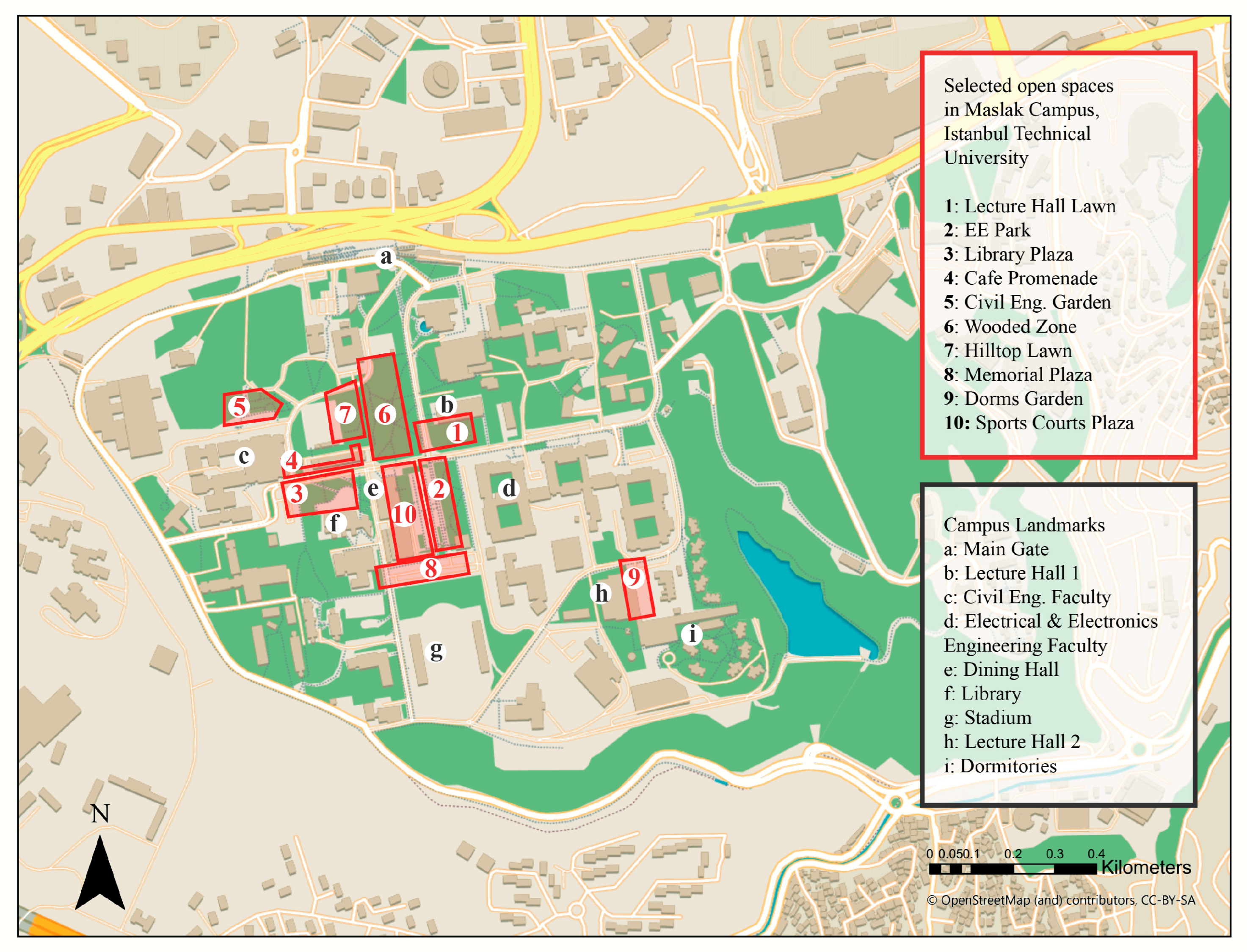

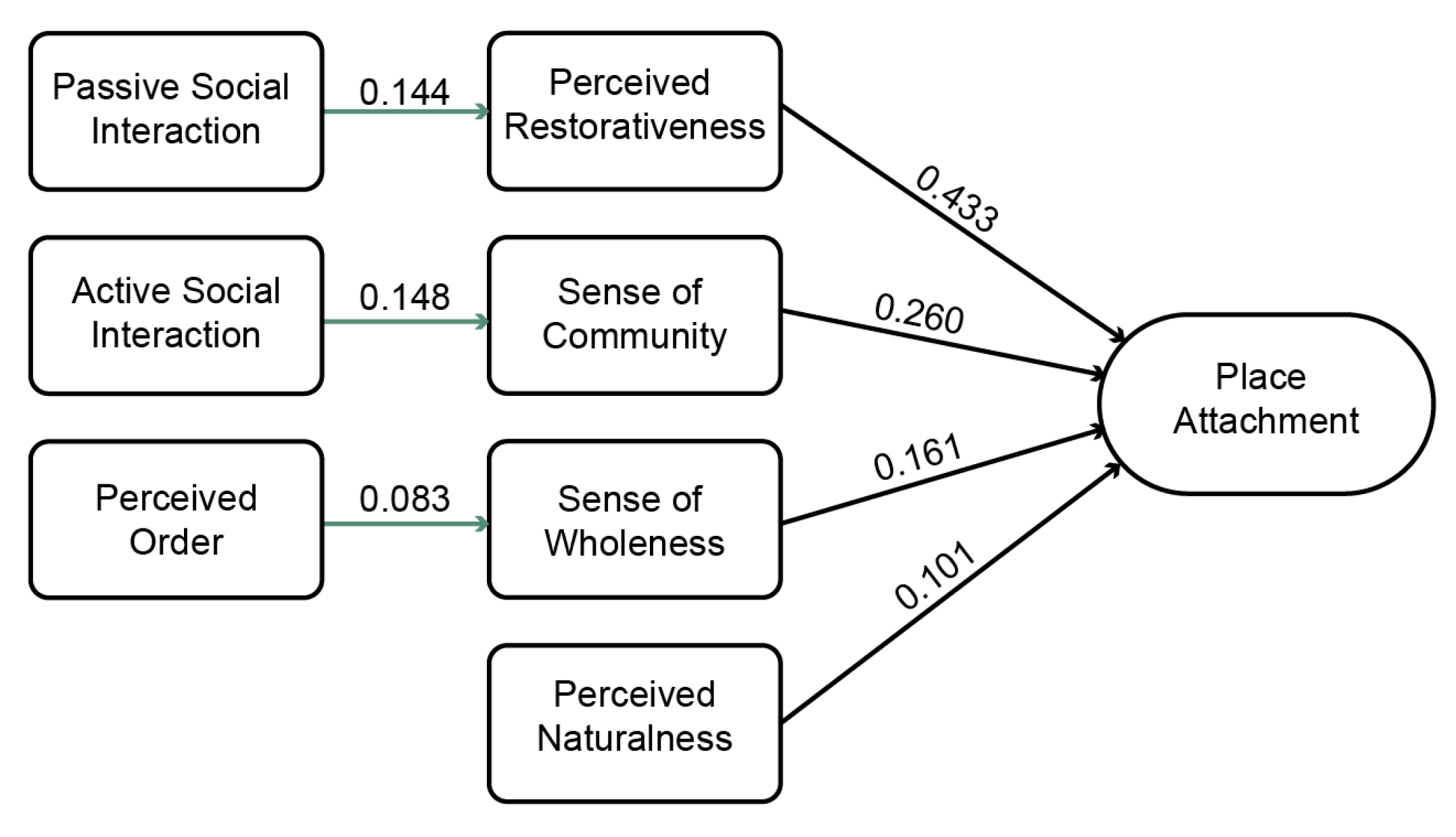
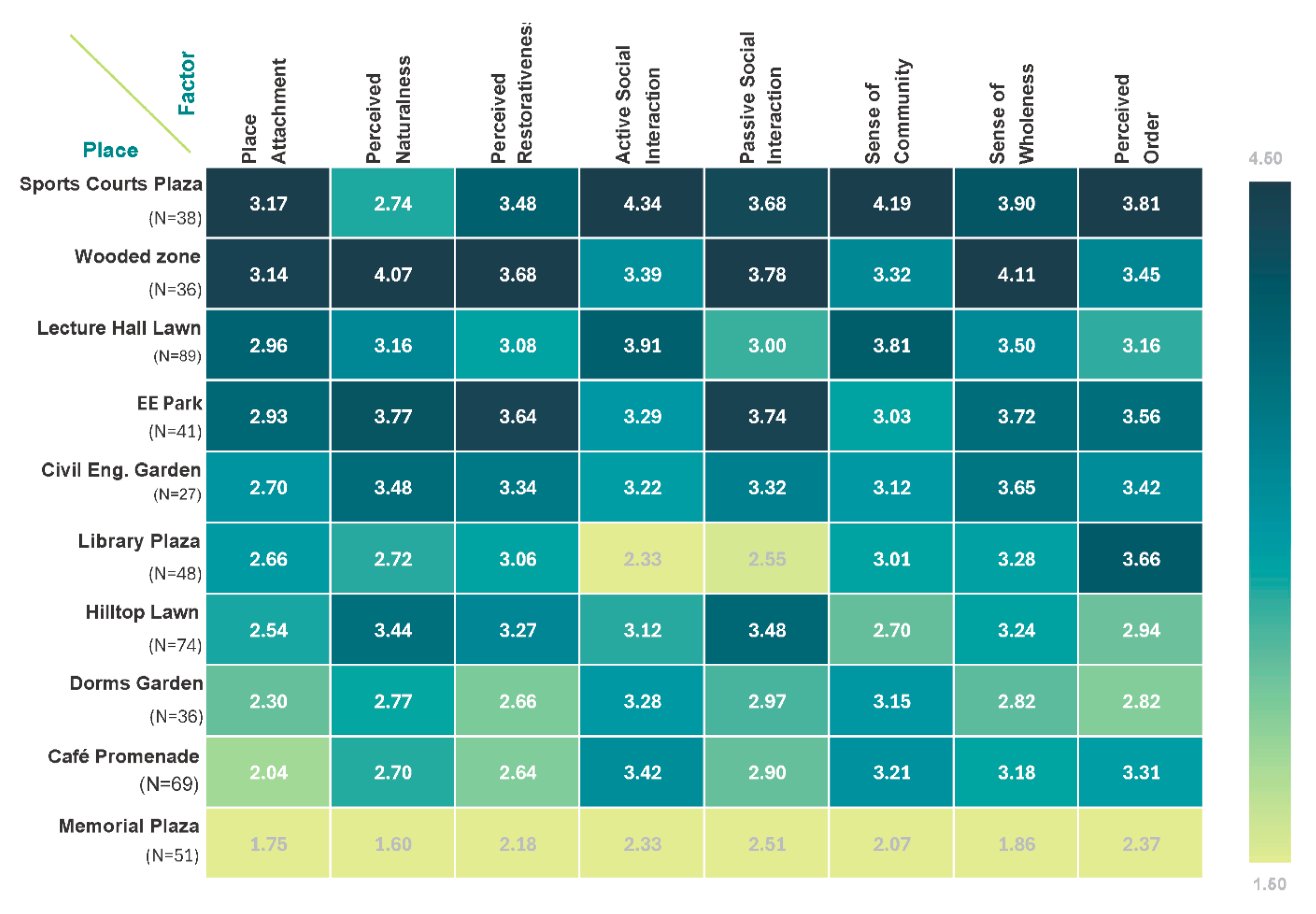
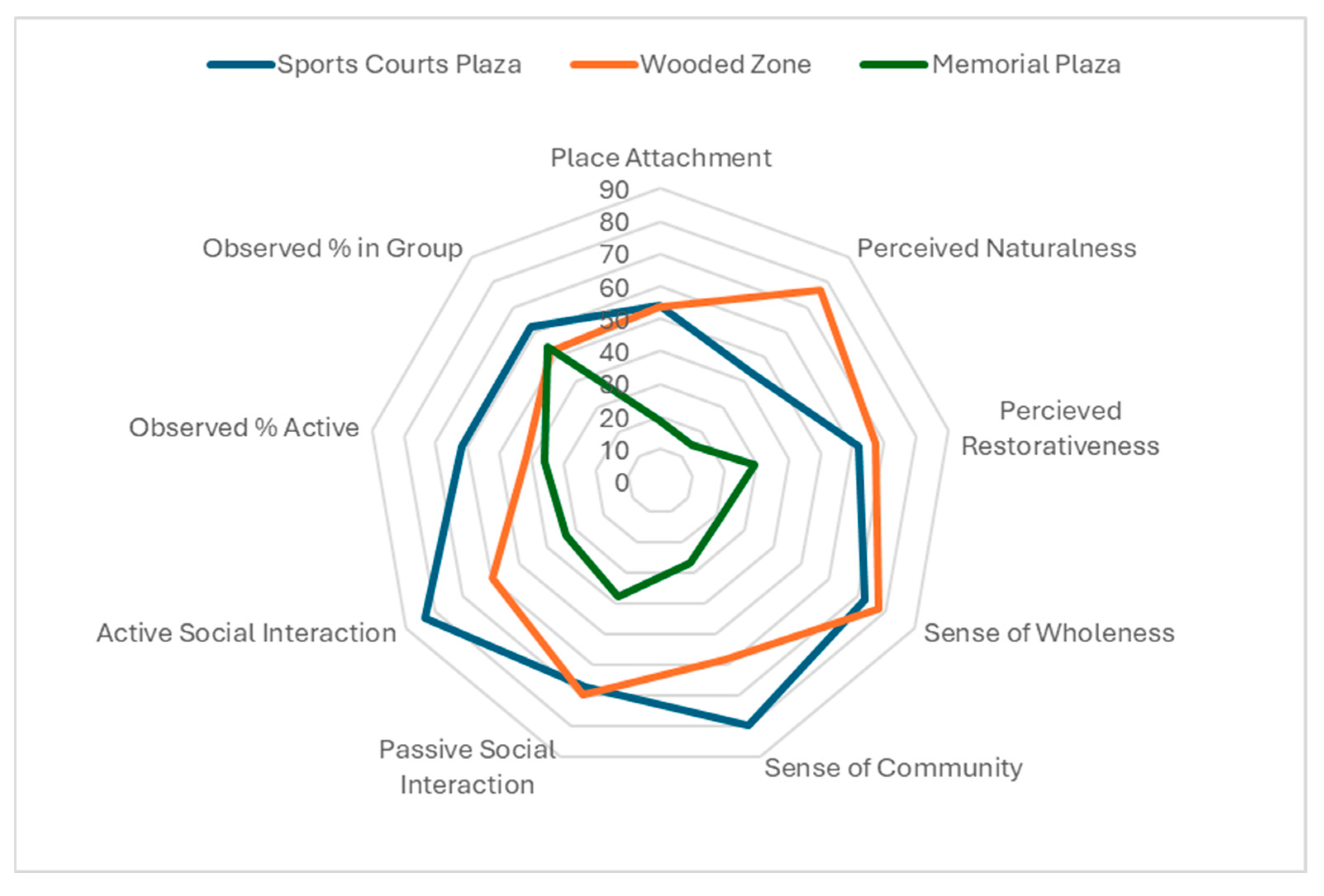
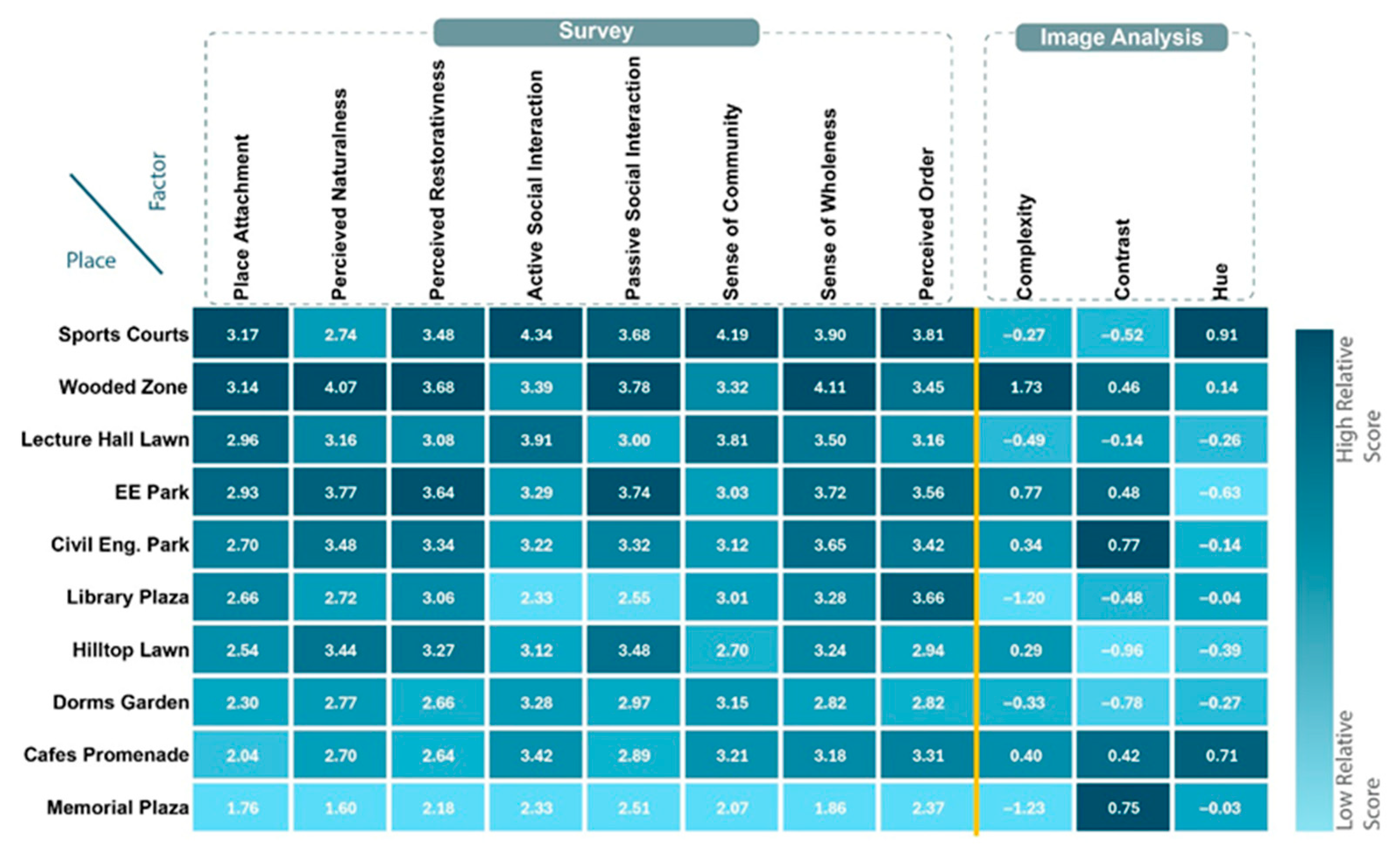
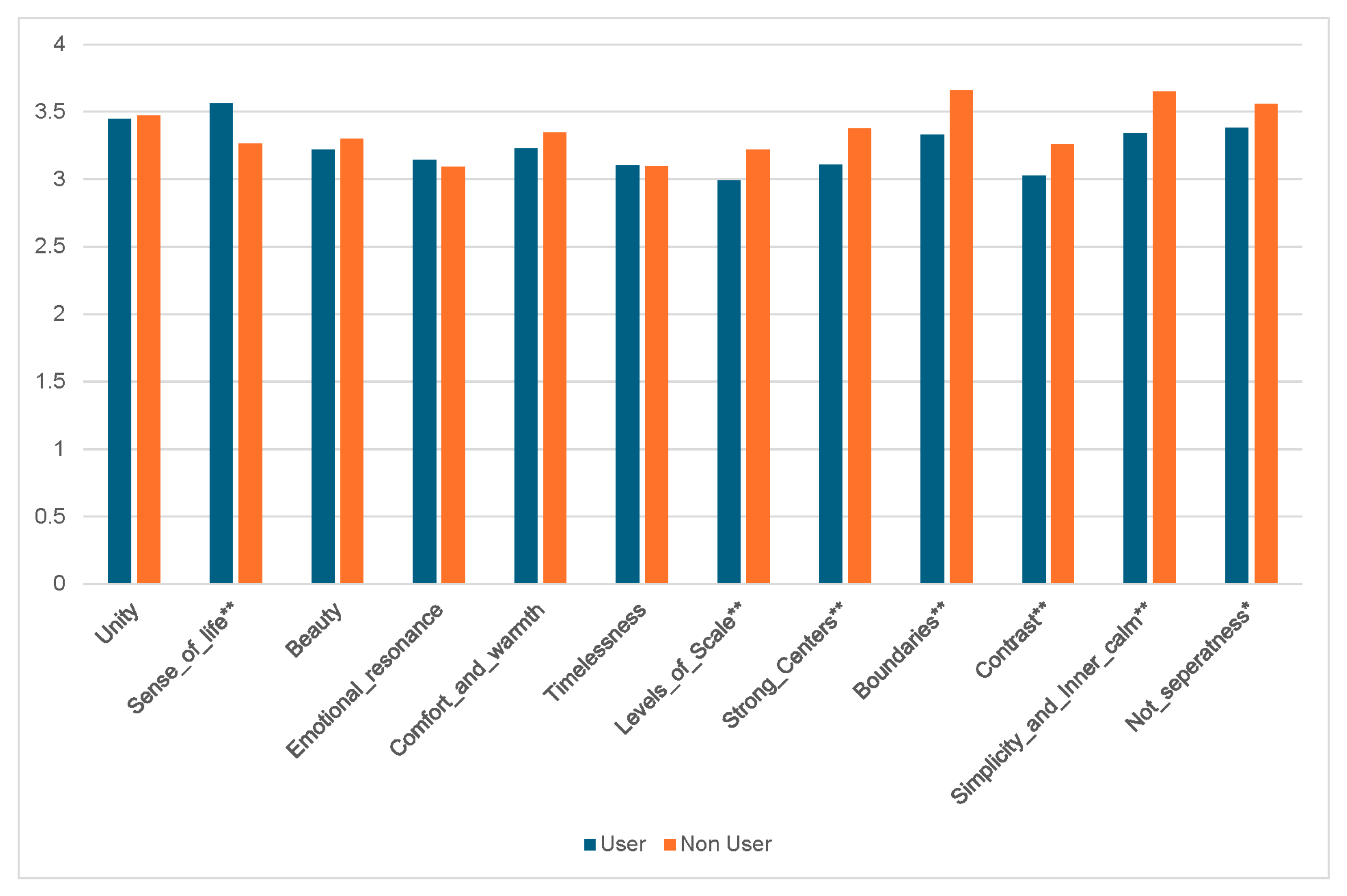
| Place | Image | Key Features | |
|---|---|---|---|
| 1 | Lecture Hall Lawn | 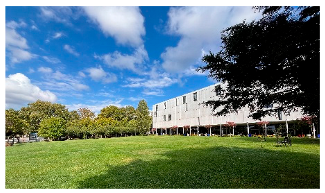 |
|
| 2 | Electrical and Electronics Engineering (EE) Park | 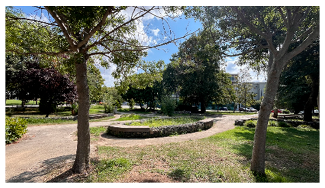 |
|
| 3 | Library Plaza |  |
|
| 4 | Café Promenade | 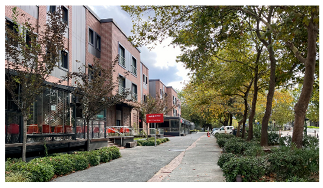 |
|
| 5 | Civil Engineering Garden | 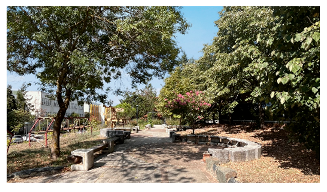 |
|
| 6 | Wooded zone | 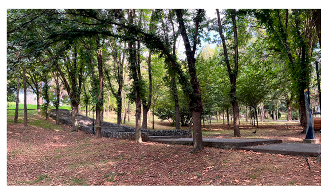 |
|
| 7 | Hilltop lawn | 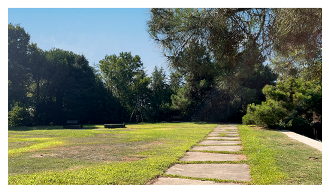 |
|
| 8 | Memorial Plaza | 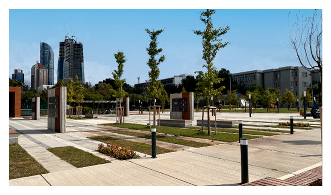 |
|
| 9 | Dorms Garden | 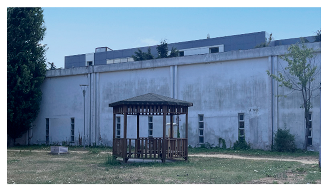 |
|
| 10 | Sports Courts Plaza | 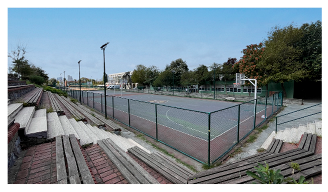 |
|
| Variable | Category | % of Sample |
|---|---|---|
| Gender | Male | 55.70% |
| Female | 41.90% | |
| Prefer not to say | 2.40% | |
| Age Group | 18–22 | 36.60% |
| 23–25 | 25.30% | |
| 26–30 | 17.60% | |
| 30+ | 20.50% | |
| Study Level | Undergraduate | 57.20% |
| Postgraduate | 34.10% | |
| Other | 8.80% | |
| Years Enrolled | <1 year | 5.50% |
| 1–3 years | 35.70% | |
| 4–6 years | 33.00% | |
| 6+ years | 25.80% | |
| Campus Presence | Every weekday | 44.80% |
| 2–3 days/week | 27.20% | |
| 1 day/week | 9.60% | |
| Sporadic | 18.30% | |
| Residence | Lives on campus | 15.20% |
| Lives off-campus | 84.80% | |
| Faculty | Faculty of Aeronautics and Astronautics | 6.60% |
| Faculty of Architecture | 11.60% | |
| Faculty of Chemical Metallurgical Engineering | 8.00% | |
| Faculty of Civil Engineering | 11.00% | |
| Faculty of Computer and Informatics Engineering | 8.60% | |
| Faculty of Electrical and Electronics | 13.00% | |
| Faculty of Management | 4.40% | |
| Faculty of Mechanical Engineering | 4.40% | |
| Faculty of Mines | 6.80% | |
| Faculty of Naval Architecture and Ocean Engineering | 3.00% | |
| Faculty of Science and Letters | 9.80% | |
| Faculty of Textile Technologies and Design | 1.80% | |
| Other | 10.80% |
| Construct | No. of Items | Cronbach’s α |
|---|---|---|
| Place Attachment | 6 | 0.93 |
| Perceived Naturalness | 5 | 0.88 |
| Perceived Restorativeness | 4 | 0.85 |
| Active Social Interaction | 3 | 0.82 |
| Passive Social Interaction | 3 | 0.76 |
| Sense of Community | 3 | 0.86 |
| Sense of Wholeness | 5 | 0.90 |
| Perceived Order | 6 | 0.78 |
| Place | Dominant Association [Pre-Defined] | Extracted Key Themes | Illustrative Quotes | Perceived Naturalness Score | Place Attachment Score | Sense of Community Score |
|---|---|---|---|---|---|---|
| Sports Courts Plaza | Social Contacts (75%) Typical of ITU (66%) Daily routine (40%) | Social hub/energy | “Socially vibrant and alive” “food” “Movement and fun” | Low–Moderate | High | High |
| Wooded zone | Peace and quiet (82%) Typical of ITU campus (65%) Daily Routine (52%) Physical and mental well-being (50%) Beauty and harmony (48%) Freedom (39%) | Quick Restorative retreat, natural quiet | “Peace, opportunity, connection to nature.” “Peace, the feeling of being lost, I want to hug the trees” “Underutilised” | High | High | Moderate |
| Lecture Hall Lawn | Typical of ITU (65%) Social contacts (65%) | University life, lively but crowded | “The social heart of campus.” “Classic campus life, grass, conversations, snacks and drinks.” “Plastic tables and chairs do not create any actual living feeling.” | Moderate | Moderate–High | High |
| EE Park | Peace and quiet (85%) Physical and mental well-being (45%) Beauty and Harmony (45%) | Semi-natural, balance of green and social use | “A calm and pleasant place to sit and study.” | High | Moderate–High | Moderate |
| Civil Eng. Garden | Peace and Quiet (70%) Unique (45%) Physical and mental well-being (38%) | Picturesque Nature | “Reminds me of Japanese gardens” “Colourful fish at the lake front of this place.” “Isolated, maybe” | Moderate | Moderate | Moderate |
| Library Plaza | Typical of ITU (60%) Peace and quiet (36%) Unique (36%) Daily routine (32%) | Transitional and symbolic space | “A meeting spot before class; not very relaxing.” “This place gives me a sense of knowledge, inspiration, peace, and the freedom to explore beyond the limits of time.” “Intellectual, core part of ITU, a place that makes ITU real ITU.” | Low–Moderate | Moderate | Low–Moderate |
| Hilltop Lawn | Peace and quiet (72%) Physical and mental well-being (39%) | secluded natural place | “A very reserved place for enjoying silence.” “This area is surrounded by trees, which makes it isolated and adds silence.” “It’s quieter, greener, and there’s not much human activity in this area, so it feels closer to nature.” | High | Moderate | Low–Moderate |
| Dorms Garden | Social contacts (49%) Nostalgia (32%) Typical of ITU (30%) | Residential, functional, semi-private | “A resting place close to the dorms.” “Relaxation, holiday vibe, rest, peace.” | Low–Moderate | Low–Moderate | Low–Moderate |
| Café Promenade | Social contacts (56%) Daily routine (42%) Typical of ITU (39%) | Transit-oriented, lively edges, functional social | “The benches are nice for a quick break, but I never use this location to sit down for an extended period of time” “Places where you can eat and rest” “An inadequate eatery that does not meet the demands and needs of students. A concrete area with a few greenery scattered around. However, the buildings look quite good.” | Low–Moderate | Low | Low–Moderate |
| Memorial Plaza | Other (40%) (e.g., waste, underutilization) | Symbolic, formal, underused | “Over-designed, too monumental, and unsuitable for everyday use.” “I feel like this place is a bit cold” | Low | Low | Low |
Disclaimer/Publisher’s Note: The statements, opinions and data contained in all publications are solely those of the individual author(s) and contributor(s) and not of MDPI and/or the editor(s). MDPI and/or the editor(s) disclaim responsibility for any injury to people or property resulting from any ideas, methods, instructions or products referred to in the content. |
© 2025 by the authors. Licensee MDPI, Basel, Switzerland. This article is an open access article distributed under the terms and conditions of the Creative Commons Attribution (CC BY) license (https://creativecommons.org/licenses/by/4.0/).
Share and Cite
Al-Azzawi, S.; İnalhan, G.; Al-Azzawi, N. Aesthetic–Restorative Qualities and Social Interaction in Public Open Spaces: Investigating the Pathways to Place Attachment. Architecture 2025, 5, 114. https://doi.org/10.3390/architecture5040114
Al-Azzawi S, İnalhan G, Al-Azzawi N. Aesthetic–Restorative Qualities and Social Interaction in Public Open Spaces: Investigating the Pathways to Place Attachment. Architecture. 2025; 5(4):114. https://doi.org/10.3390/architecture5040114
Chicago/Turabian StyleAl-Azzawi, Sana, Göksenin İnalhan, and Nada Al-Azzawi. 2025. "Aesthetic–Restorative Qualities and Social Interaction in Public Open Spaces: Investigating the Pathways to Place Attachment" Architecture 5, no. 4: 114. https://doi.org/10.3390/architecture5040114
APA StyleAl-Azzawi, S., İnalhan, G., & Al-Azzawi, N. (2025). Aesthetic–Restorative Qualities and Social Interaction in Public Open Spaces: Investigating the Pathways to Place Attachment. Architecture, 5(4), 114. https://doi.org/10.3390/architecture5040114







